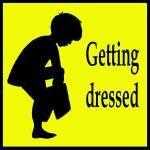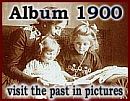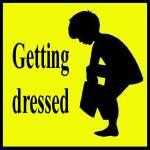
German 1920s Getting Dressed Chronology: Friederich' Outer Garments

Figure 1.--Here we see Friederich in the 1920s. His hair is worn longer than it would have in the previous decades, in his case cut in bangs. He wears a white shirt with a shiller collar and button-on short pants. He has heavy high-top shoes. Drawing by Birte Koch.
|
|
Friedrich is 4 years old. Here we see Friederich in the 1920s. He is not yet old enough to school, even Kingdergarten. I don't think nursery schools were common at the time. His hair is worn longer than it would have in the previous decades, in his case cut in bangs. As a younger boy it might have been worn long over his ears. When he was ready to begin school his hair would have been cut shorter, but might still be done with basngs. He wears a white shirt with a Schiller collar. The Schiller collar was a very popular style in the 1920s for boys of all ages--but not for adults. He has button-on short pants. There were buttons at the waist that fit into button wholes at the hem of the shorts. Short pants might still be quite long in the 1920s, but note they do not have the ornamental buttons at the leg hem. He wears short white socks, but probably wore long stockings when the weather got cooler. He has heavy high-top shoes. These would have been worn
School
Friederich is not yet old enough to school, even Kingdergarten. I don't think nursery schools were common at the time.
Garments
We know a good bit about the clothes that Friederich would have worn.
Headwear
I'm not sure what kind of cap Friederich might have worn. My guess is that a sailor cap might have been most likely.
Shirt
Friederich wears a white shirt with a Schiller collar. The Schiller collar was a very popular style in the 1920s for boys of all ages--but not for adults. They were especially common in white. All of the German images we have are white. We are not sure if they were even done in colors and stripes in Germany. Perhaps HBC readers will know more. (The comparable sports collars in America were also mostly white, but we have noted some done in colors and stripes as well.) The Schiller collars were popular with boys because they were a comfortable open collar style.
Pants
He has button-on short pants. There were buttons at the waist that fit into button wholes at the hem of the shorts. These button-on shorts were one approach to holding up a younger boy's pants. Belts were not common. Perhaps even more popular for Germany boys were suspender shorts. Boys might wear suspenders or have suspender straps fone in the same material of the shorts. These were often dinr in a "H"-bar style like Lederhosen. Short pants might still be quite long in the 1920s, but note they do not have the ornamental buttons at the leg hem. Boys began wearing shorter cut shorts in the 1920s, especially younger boys. But many boys like Friedrich here continued to wear shorts just at the knee level. We are not positive about the color because so many period photographs were still black nd white. We think though that brown was a common color. A reader writes, "I am curious about what kind of fly Friederich's shorts had. I've seen pictures of button-on shorts that appear to open at either side, thus making a full-width fall-front fly. I presume that Friederich would pee by unbuttoning the buttons
at the front of his shirt and at the side of his shorts, and the whole front would open up. This illustration doesn't make that clear, so I can only guess." This is certainly possible. We also think that shorts for younger boys were often made without flies.
Hosiery
Friederich here wears short white socks. The ankle socks for younger children were commonly white. He probably wore long stockings when the weather got cooler. The long stockings in the 1920s were common various shades of brown or grey, but black and white might be worn for more formal occassions.
Footwear
He has heavy high-top shoes. These would have been worn for play although boys his age ,ight have gone barefoot when playing. This depended somewhat on wether he loved in the city or village and the social status of his parents. Fir dress occassions he probably would have had a pair of black strap shoes. He might have also had a red pair for play. Here also there were social class variations.
Hair
His hair is worn longer than it would have in the previous decades, in his case cut in bangs. As a younger boy it might have been worn long over his ears. When he was ready to begin school his hair would have been cut shorter, but might still be done with bangs.
HBC

|
Album1900

|
Navigate the Boys' Historical Clothing Web Site:
[Return to the Main German Getting Dressed 1920s Outer Garments page]
[Return to the Main German page]
[Introduction]
[Activities]
[Biographies]
[Chronology]
[Clothing styles]
[Countries]
[Essays]
[Bibliographies]
[Contributions]
[FAQs]
[Glossaries]
[Satellite sites]
[Tools]
[ Boys' Clothing Home]
Created: 6:15 AM 12/21/2005
Last updated: 1:12 PM 1/8/2006



